Breadcrumbs
STB Samples
1. Visual Memory Subtest: Learning Phase
In the Visual Memory Subtest, there are two parts. The first part is the Visual Memory: Learning Phase, in which you will have to memorize a number of irregular shapes, parts of which are blackened. The second part is the Visual Memory: Recall Phase, which you will see about 30 minutes later, after completing two other subtests. In the Visual Memory: Recall Phase, you will need to identify the shapes you memorized during the Learning Phase. The items will be presented in the Recall phase as sets of identically shaped figures with different blackened parts. These could be some of the shapes you have to memorize:
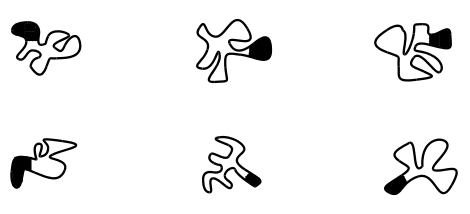
Later in the Spatial Test Battery, the same shape will be presented among different, though similar, figures. See below for examples for the Recall Phase. Remember that you will have to complete two other subtests before you are presented with the Recall Phase to identify the shapes you memorized earlier.
2. Surface Development Subtest
In the Surface Development Subtest, you will see irregular, flat shapes, such as pieces of paper or cardboard, and boxes created by folding these shapes; it will be your task to find out which lines on the flat shapes correspond to lines on the boxes. In the flat shapes, like the ones shown below, the solid lines indicate the edges of the shape, and the dashed lines show you where it can be folded. An arrow on each flat shape and the respective box will help you identify the orientation of the box relative to the shape.
Video: How the pattern folds to form the box
Rotating images will only be available during the tutorial–not during the actual test.
In the sample tasks below, try to find out what letter(s) on the boxes correspond to each of the five numbers on the flat shapes.

3. Block Rotation Subtest
This subtest measures your ability to mentally rotate blocks in space. In the Block Rotation subtest, you will see blocks of different shapes, with cubes, cylinders, and other objects on them. In the examples below, you see six images. The image in the upper left-hand corner shows the model block. One of the five images labeled A through E also shows the model block, but rotated in space. The remaining images show a different block, rotated to various positions in space. Your task is to choose from the images labeled A through E the image that shows the model block rotated in space.
Video: How the block looks as it rotates to different positions
Rotating images will be available during the tutorial only–not during the actual test.
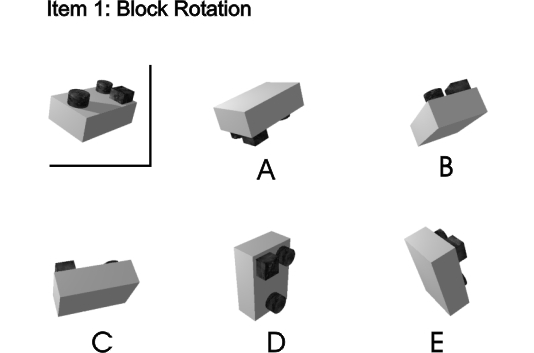
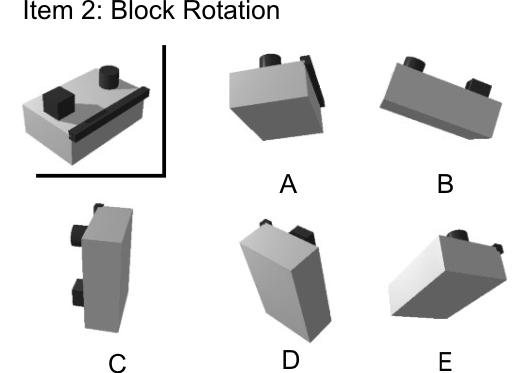
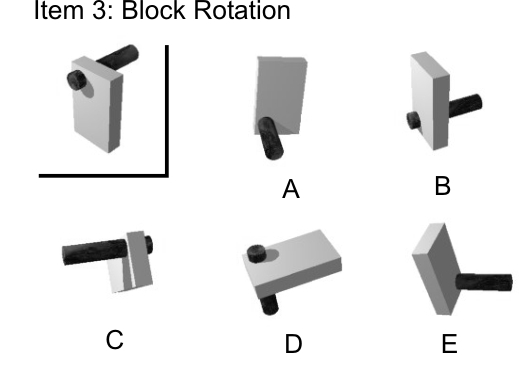


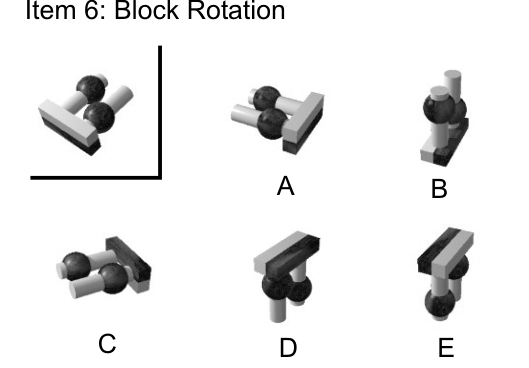

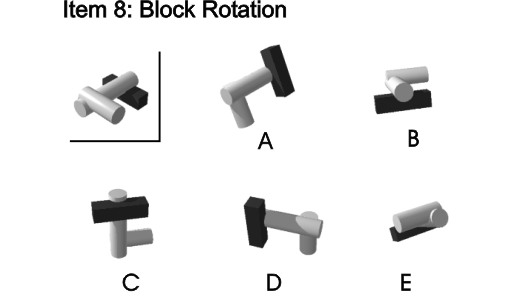
4. Visual Memory Subtest: Recall Phase
In the Visual Memory: Recall Phase, you will have to remember images that you memorized during the Visual Memory: Learning Phase. Keep in mind that the Recall Phase occurs approximately 30 minutes after the Learning Phase. Take a moment to remember the shapes from Visual Memory: Learning Phase. Can you pick them out in the examples below? Note that these shapes will be presented only after you have completed the Surface Development subtest and the Block Rotation subtest. This is how the shapes will be presented later among other figures:






In the Learning Phase of this subtest, it is not important to memorize the order of the shapes or where they appear on the screen. The task is to memorize the contours of the shapes and where they are blackened. In the actual test, you will have to memorize 22 shapes (15 shapes if you are a 5th- or 6th-grader). Use all of the time allotted wisely. Students who spend more time memorizing do better on the Recall Phase!
5. Perspectives Subtest
Note: 5th- and 6th- graders do not take the Perspectives Subtest.
style="clear:both;"As you move around in the real world, you see many different viewpoints or perspectives of the same objects and scenes. This test will measure your ability to imagine how things look from different perspectives.
In this test, you will see spheres that move together as a group. Throughout the items, these spheres will be two different shades of gray, light and dark. All spheres are the same size. Spheres that appear larger and closer to you, and spheres that appear smaller and farther away. Note that some spheres may be hidden behind those that you see.
Look at the example below, showing the FRONT view of the group of spheres:
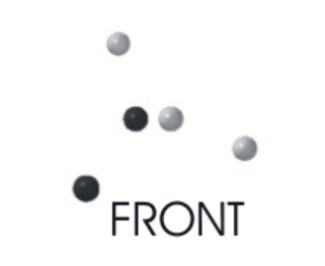
If you imagine walking around this group of spheres or imagine the group rotating as a whole, you could see it from other perspectives. For instance, you might see it from the LEFT or from the RIGHT as indicated below:

The following examples will show you four of the perspective changes that occur in the test.
Below, Picture #1 shows the FRONT view of the group of spheres. Picture #2 shows the same group after a 90-degree rotation (RIGHT view).
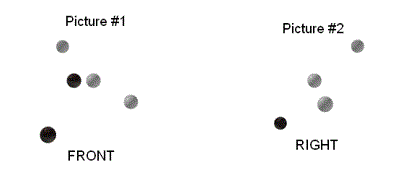
Video: How the group rotates 90 degrees from the FRONT view (Picture #1) to the RIGHT view (Picture #2)
The following images show the opposite rotation, resulting in the LEFT view.
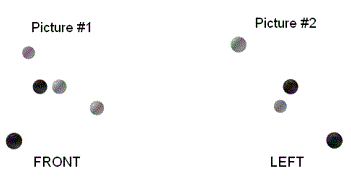
Video: Watch this rotation
The following images show the vertical 90-degree rotation that ends in the view of the group of spheres from above (ABOVE view).
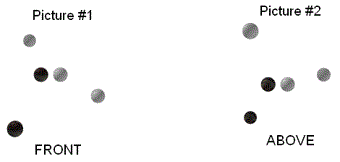
Video: Watch this rotation
The last example shows the 90-degree rotation that ends in the view of the group of spheres from below (BELOW view).

Video: Watch this rotation
In the test, you will see more groups of spheres. In every problem, you will see two pictures of the same group. Picture #1 will always show the FRONT view. Your task will be to figure out whether Picture #2 is the view from the RIGHT, from the LEFT, from ABOVE, from BELOW, or from BEHIND. (The BEHIND view is not shown in the movies above).
If you still have time, you may go back and practice the rotations.
All images in the actual test will be static. Rotating images will be shown only in the tutorial preceding the test. Here are six sample questions.
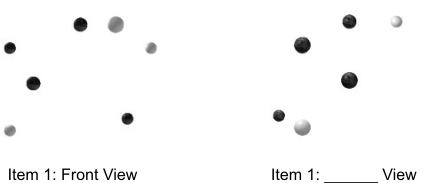
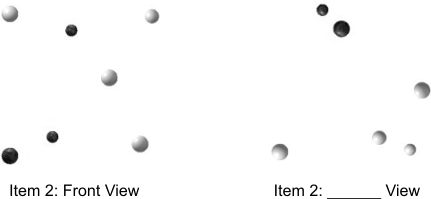

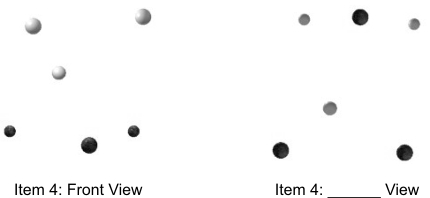

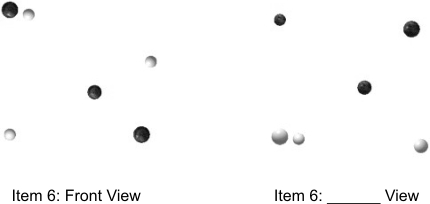
Answers
Surface Development Answers
- Item 1: 1=B 2=H 3=E 4=H 5=J
- Item 2: 1=H 2=G 3=H 4=D 5=A
- Item 3: 1=L 2=A 3=O 4=E 5=B
- Item 4: 1=V 2=I 3=O 4=C 5=X
Block Rotation Answers
- Item 1=A
- Item 2=B
- Item 3=A
- Item 4=C
- Item 5=E
- Item 6=C
- Item 7=C
- Item 8=D
Perspectives Answers
- Item 1=Left
- Item 2=Above
- Item 3=Right
- Item 4=Below
- Item 5=Above
- Item 6=Below
Visual Memory Answers
- Item 1=E
- Item 2=A
- Item 3=C
- Item 4=B
- Item 5=D
- Item 6=B

